Berryteuthis magister
Commander squid
Tsunemi KuboderaBerryteuthis magister: Holotype (153mm ML, 295mm TL), collected at Puget Sound, Washington, U.S.A. Photo from Berry (1912).



This tree diagram shows the relationships between several groups of organisms.
The root of the current tree connects the organisms featured in this tree to their containing group and the rest of the Tree of Life. The basal branching point in the tree represents the ancestor of the other groups in the tree. This ancestor diversified over time into several descendent subgroups, which are represented as internal nodes and terminal taxa to the right.

You can click on the root to travel down the Tree of Life all the way to the root of all Life, and you can click on the names of descendent subgroups to travel up the Tree of Life all the way to individual species.
For more information on ToL tree formatting, please see Interpreting the Tree or Classification. To learn more about phylogenetic trees, please visit our Phylogenetic Biology pages.
close boxIntroduction
B. magister was designated by Berry (1913) based on two large specimens from Puget Sound, Washington. Berry (1912)gave a detailed description, drawings and photos of these specimens as a different form of Gonatus fabricii in his "Cephalopods of western North America". Later he obtaind a true G. fabricii from the Irish coast in the Atlantic and considered that the Puget Sound specimens represented a new species and named it Gonatus magister. Naef (1921) placed this species in a new genus Berryteuthis based on Berry's description, characterized by having large fines (FL>1/2ML) and no hooks on the clubs. Until Pearcy and Voss (1964) described B. anonychus from off Oregon, B. magister was the sole species of the genus Berryteuthis.
Diagnosis
A Berryteuthis with ...
- length to 42-43 cm ML and weight to 2.2-2.6 kg.
- large hooks present in medial series of arms I-III in large individuals of both sexes.
Characteristics
- Arms
- Arms stout, of moderate length (<60% ML), slightly unequal, II,III>I, IV.
- Arm III = 62% ML.
- Arm IV comprising 4 rows of suckers.
- Arms I-III with 2 median rows of hooks and 2 marginal rows of suckers with long trabeculae.
- Tentacles
- Stout and rather short, TL<ML.
- Tentacular clubs broadly expanded with well marked narrow dactylus and aboral keel.
- Club without hooks, with numerous minute suckers; suckers in median portion of manus much larger than in marginal areas.
- Locking apparatus, consisting of a series of small pads and suckers, along the entire dorsal margin of the club manus.
- Stout and rather short, TL<ML.
- Head
- Head large, as broad as or a little broader than mantle opening.
- Funnel broadly conical, funnel organ with inverted V-shaped pad with two ovate lateral ones.
- Beaks. Description of the beaks can be found here: Lower beak; upper beak. See also this site.
- Radula with 7 longitudinal rows of teeth, central tooth tricuspidate, first lateral teeth bicuspidate, second and marginal teeth unicuspidate, horn-like.
- Mantle
- Mantle cylindrical and broad (MW=30% ML).
- Mantle cylindrical and broad (MW=30% ML).
- Fins and tail
- fins large rhomboidal, Fl>50% ML, FW>FL.
- mantle without distinct tail.
- Photophores
- no photophores externally and internally.
Comments
B. magister has been reported widely from the west coast of Oregon, northward to Alaska Bay, Aleutian and Kurile Islands, including the Bering Sea and the Sea of Okhotsk, down southward to the Sea of Japan and northeastern Honshu, Japan. Individuals living in the northern area tend to grow larger in size and attain up to 38 cm ML. Those large individuals have a little different external morphology and bodily proportions as well as tentacular club structures from the holotype described from near the southeastern border of their distribution (see distribution map).

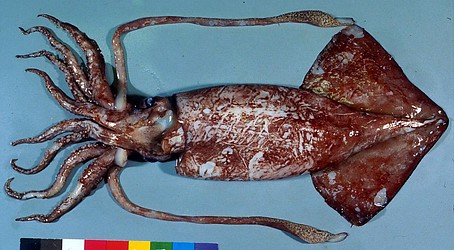
Figure. Berryteuthis magister (28cm ML) collected off Erimo, Hokkaido. Photo by Kubodera (2005)
Recently, two sub-species under B. magister have been reported from off Hokkaido (B. magister nipponensis Okutani & Kubodera, 1987) and the Sea of Japan (B. magister shevtsovi Katugin, 2000). These sub-species came from the southwestern border of the distribution of B. magister. This indicates that the speciation of this group would be advanced in the southern peripheral regions of both east and west of their distribution, including the holotype.
Life History
Morphological change with growth of B. magister was reported by Kubodera and Okutani (1981). Paralavae of B. magister between 7 - 16 mm ML can be identified by having a stumpy bell-shaped mantle with small fins, large head with short, thick and stout arms and stout tentacles with 8-10 longitudinal rows of densely beset small suckers on the proximal portion of the immature clubs which are covered with minute sucker buds without a large central sucker bud.

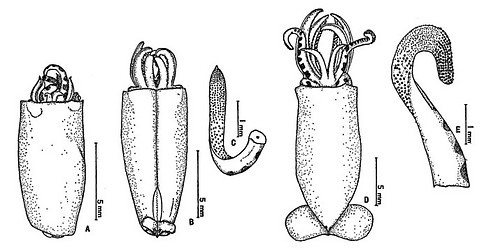
Figure. Morphological change with growth of B. magister. A: ventral view of a 9 mm ML specimen, B: dorsal view of a 12 mm ML specimen, C: tentacle of B, D: ventral view of a 16 mm ML specimen, E: tentacle of D. Drawings from Kubodera and Okutani (1981).
Paralarvae can be identified by the dorsal-head chromatophore pattern which is Type I,1 (three tear-shaped chromatophores on each side plus one additional chromatophore in the midline of the head.); the mantle has 20-25 dorsal chromatophores (Jorgensen, 2006)
Distribution
The distribution of B. magister is reported widely from subarctic waters in the North Pacific. It is especially abundant near the bottom off the continental shelf (deeper than 300m). B. magister is an important bottom trawl catch for Russian fisheries in the western Bering Sea and in the Sea of Okhotsk.
References
Berry, S.S. 1912. A Review of the Cephalopods of Western North America. Bulletin of the Bureau of Fisheries, 30(1910):267-336.
Berry, S.S. 1913. Notes on some West American cephalopods. Proceedings of the Accademy of Natural Sciences of Philadelphia: 72-77.
Jorgensen, E. M. 2007. Identification, distribution and relative abundance of paralarval gonatid squids (Cephalopoda: Oegopsida: Gonatidae)from the Gulf of Alaska, 2001-2003. Journ. Molluscan Studies, 73: 155-165.
Katugin, O.N. 2000. A new subspecies of the schoolmaster gonate squid, Berryteuthis magister (Cephalopoda: gonatidae), form the Japan Sea. The Veliger 43(1): 82-97.
Kubodera, T. and T. Okutani, 1981. The systematics and identification of larval cephalopods from the northern North Pacific. Research Institute of North Pacific Fisheries, Special Volume, 131-159 pp.
Okutani, T., T. Kubodera and K. Jefferts. 1983. Diversity, distribution and ecology of gonatid squids in the subarctic Pacific: A review. Bull. Ocean Res. Inst., Univ. Tokyo, No. 26 (1):150-192.
Okutani, T. and T. Kubodera, 1987. Berryteuthis magister nipponensis Okutani & Kubodera, n. sbsp. In Cephalopods from continental shelf and slope around Japan: 132-135. Japan Fisheries Resource Conservation Association, Tokyo.
Sasaki, M. 1929. A Monograph of the Dibranchiate Cephalopods of the Japanese and Adjacent Waters. Journal of the College of Agriculture, Hokkaido Imperial University, 20(supplement):357 pages.
About This Page
Tsunemi Kubodera

National Science Museum, Tokyo, Japan
Correspondence regarding this page should be directed to Tsunemi Kubodera at
Kubodera@kahaku.go.jp
Page copyright © 2015 Tsunemi Kubodera
 Page: Tree of Life
Berryteuthis magister . Commander squid.
Authored by
Tsunemi Kubodera.
The TEXT of this page is licensed under the
Creative Commons Attribution-NonCommercial License - Version 3.0. Note that images and other media
featured on this page are each governed by their own license, and they may or may not be available
for reuse. Click on an image or a media link to access the media data window, which provides the
relevant licensing information. For the general terms and conditions of ToL material reuse and
redistribution, please see the Tree of Life Copyright
Policies.
Page: Tree of Life
Berryteuthis magister . Commander squid.
Authored by
Tsunemi Kubodera.
The TEXT of this page is licensed under the
Creative Commons Attribution-NonCommercial License - Version 3.0. Note that images and other media
featured on this page are each governed by their own license, and they may or may not be available
for reuse. Click on an image or a media link to access the media data window, which provides the
relevant licensing information. For the general terms and conditions of ToL material reuse and
redistribution, please see the Tree of Life Copyright
Policies.
- First online 30 May 2006
- Content changed 11 October 2015
Citing this page:
Kubodera, Tsunemi. 2015. Berryteuthis magister . Commander squid. Version 11 October 2015. http://tolweb.org/Berryteuthis_magister/26875/2015.10.11 in The Tree of Life Web Project, http://tolweb.org/





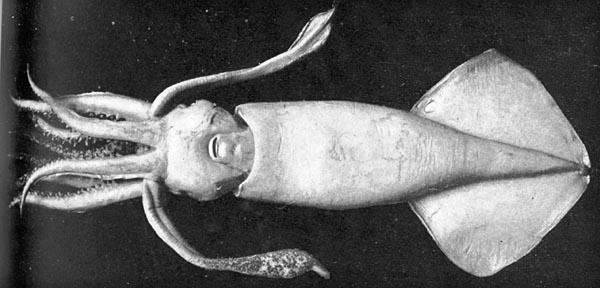

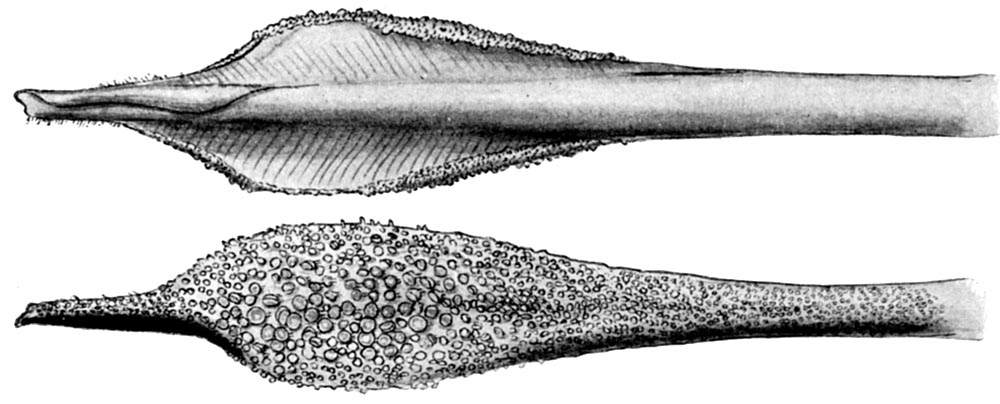
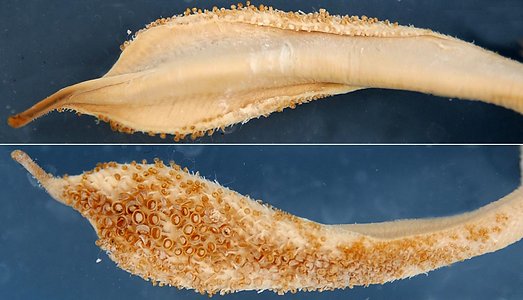
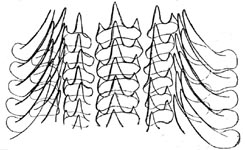
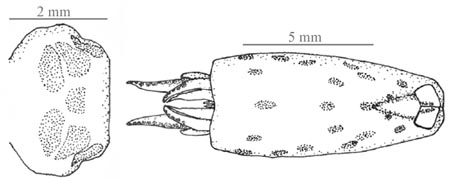
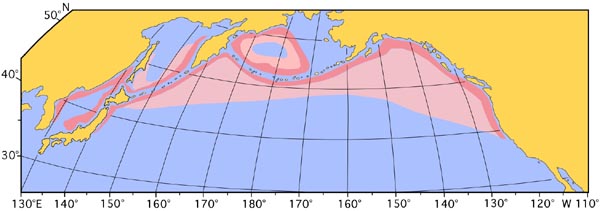


 Go to quick links
Go to quick search
Go to navigation for this section of the ToL site
Go to detailed links for the ToL site
Go to quick links
Go to quick search
Go to navigation for this section of the ToL site
Go to detailed links for the ToL site